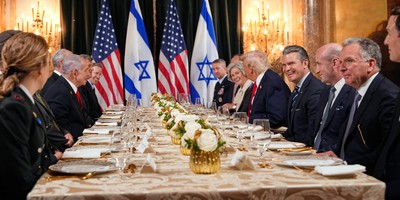The Islamic Republic of Iran has been the site of profound unrest since the end of 2017.
December of that year marked the beginning of countrywide protests lasting weeks that spread to more than 100 localities with Iranians chanting slogans condemning the theocratic regime and calling for “death to the dictator.” In November 2019, an even larger uprising prompted a repressive response by Iranian authorities that led to more than 1,500 protestors being killed. Since then, at least seven further revolts against the regime have materialized.
The anti-government slogans from the first uprising remain in common use, and Iran’s ruling theocracy is today struggling to deny the existence of a credible public movement for regime change. In January 2018, Supreme Leader Ali Khamenei remarked in a speech that Iran’s leading pro-democracy opposition group, the People’s Mojahedin Organization of Iran (PMOI/MEK), had “planned for months” to facilitate demonstrations and popularize the slogans espousing its platform.
Since then, the regime has failed to reassert its earlier position that the MEK is a “cult” with little political influence or social support. Neither has Tehran found success in the false narrative that pro-democracy dissidents reflect foreign meddling. Authoritarian regimes can only recode internal dissent as external threats for so long.
Now, the regime’s clerical rulers are adopting a strategy of attempting to shift public attention from the pro-democracy opposition towards a small, artificially inflated movement to restore the Pahlavi dynasty, which was overturned in 1979.
That year’s popular revolution reflected widespread outrage at the brutal repression, systemic corruption, and disregard for the public will under the Shah’s regime. But Ruhollah Khomeini promptly co-opted the movement after his return from exile in France to establish a system of absolute rule by religious clerics, installing himself as its head.
The consequences for both the Iranian people and international security became almost immediately apparent. But for a long time, Tehran sought to deflect calls for regime change by suggesting that beneficial changes might come from a “reformist” faction within the regime itself. This narrative was loudly rejected by the Iranian people during the January 2018 uprising when slogans condemning both the “reformist” and “hardline” factions became commonplace, and the Iranian people made clear that “the game is over.”
Recommended
Khamenei himself seemed to acknowledge as much in February 2020, and again in 2021, when he directed the overseers of parliamentary and presidential elections to bar any so-called reformist candidates from the ballots, a decision that underscored the regime’s monolithic status. This culminated in the appointment of Ebrahim Raisi to the presidency – a cleric notorious for his role in human rights abuses, including the 1988 massacre of political prisoners that claimed an estimated 30,000 lives, most of them MEK members.
The abandonment of the hardline/reformist “game” further incentivized the Iranian people to push for regime change despite the risk of violent reprisals. Just as importantly, it exposed the fallacy of Western policies that for too long relied on the extension of olive branches premised on a false narrative that appeasement would set the regime on a path to reform itself.
Today, it is increasingly clear that there are hundreds of high-profile political figures, diplomats, policymakers, and senior military officials in Western government circles representing a range of political parties in the United States and Europe that are deeply opposed to conciliatory measures.
These individuals, who have long cast their lot with Iran’s democratic Resistance, have sometimes struggled to prevail upon their colleagues to understand what academics that study the regime have long understood – the only means of seriously addressing threats posed by the Islamic Republic is the promotion of policies that weaken the theocracy by supporting efforts amongst the Iranian people to overthrow it.
With Tehran’s reformist pipedream collapsing and persistent anti-government discontent challenging the myth that a democratic transition is impossible, Western officials have more reason than ever to support Iran’s pro-democracy activists.
To undermine such prospects, Tehran is attempting to associate regime change with a return to the past and support for a system of government that is just as undemocratic as clerical rule. Toward that end, Iran’s Ministry of Intelligence and Security issued a directive amidst the uprisings that directed agents to infiltrate demonstrations, to “chant slogans against high prices and for Reza Shah’s soul to be blessed,” and to “encourage the people to repeat these slogans” until they drown out others that authorities deem too “sharp and radical.”
The efforts have only been minimally successful.
Recent government-linked social media accounts have responded to large-scale protests by posting footage with manipulated audio suggesting that participants were calling for “Reza Shah’s soul to be blessed.” But independent media reports confirm that, in many recent demonstrations, Iranians were simply emphasizing their insistence on democratic governance.
Alongside “death to the dictator” and “death to Raisi,” one of the most familiar activist slogans in recent years has been “down with tyranny, be it the mullahs’ or the Shah’s.” The international community should pay attention to these calls. Policymakers need to understand that the outcome of a new Iranian revolution will not be a return to the country’s illiberal monarchic past or the easily manipulated chaos of 1979.
The public demand for democracy points the way to a democratic future, not a despotic past.

























Join the conversation as a VIP Member